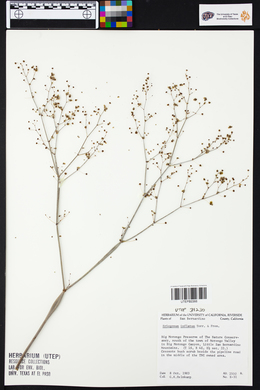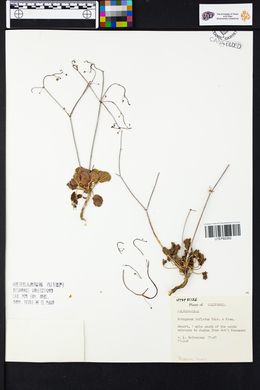Eriogonum inflatum
|
|
|
|
Family: Polygonaceae
desert trumpet, more...Indian-Pipeweed, Native American pipeweed (es: guinagua, te)
|
Herbs, erect, perennial, occasion-ally flowering first year, 1-10(-15) dm, glabrous, usually glaucous, grayish. Stems: caudex compact; aerial flowering stems erect, solid or hollow and fistulose, (0.2-)2-5 dm, glabrous, usually glaucous, occasionally hirsute proximally. Leaves basal; petiole 2-6 cm, hirsute; blade oblong-ovate to oblong or rounded to reniform, (0.5-)1-2.5(-3) × (0.5-)1-2(-2.5) cm, short-hirsute and grayish or greenish on both surfaces, sometimes less so or glabrous and green adaxially, margins occasionally undulate. Inflorescences cymose, open, spreading to erect, 5-70 × 5-50 cm; branches occasionally fistulose, glabrous, usually glaucous; bracts 3, scalelike, 1-2.5(-5) × 1-2.5 mm. Peduncles erect, straight, filiform to capillary, 0.5-2(-3.5) cm, glabrous. Involucres turbinate, 1-1.5 × 1-1.8 mm, glabrous; teeth 5, erect, 0.4-0.6 mm. Flowers (1-)2-3(-4) mm; perianth yellow with greenish or reddish midribs, densely hirsute with coarse curved hairs; tepals monomorphic, narrowly ovoid to ovate; stamens exserted, 1.3-2.5 mm; filaments glabrous or sparsely pubescent proximally. Achenes light brown to brown, lenticular to 3-gonous, 2-2.5 mm, glabrous. 2n = 32. Flowering year-round. Sandy to gravelly washes, flats, and slopes, mixed grassland, saltbush, creosote bush, mesquite, and sagebrush communities, pinyon and/or juniper woodlands; -30-1800(-2000) m; Ariz., Calif., Colo., Nev., N.Mex., Utah; Mexico (Baja California, Sonora). The cause of the fistulose stem and inflorescence branches in Eriogonum inflatum was imaginatively attributed by A. M. Stone and C. T. Mason (1979) to the larvae of gall insects. This fallacy continues to appear in the literature. Greenhouse studies have shown that stems of this and some other species of the genus inflate without the presence of any insects. Other researchers have shown that the inflation involves a build-up of CO2 within the stems, which take over as the primary photosynthetic body as leaves wilt or eventually dry up and fall away from the plant (C. D. Osmond et al. 1987). Not all individuals of E. inflatum will have fistulose stems and branches, as this feature is partly a function of available moisture: the drier the conditions, the less pronounced the inflation. Stems produced in the summer tend to be inflated less frequently than those produced in the spring. The 'annual' phase of Eriogonum inflatum is distinct from its truly annual relatives. Its flowering stems and inflorescence branches are distinctly grayish, whereas those of the true annuals are green or yellowish green. As circumscribed here, Eriogonum inflatum occurs in Arizona, southern and east-central California, western Colorado, northwestern New Mexico, central and southern Nevada, and southern and eastern Utah. Some Native Americans occasionally ate newly emerged stems of Eriogonum inflatum (S. A. Weber and P. D. Seaman 1985; M. L. Zigmond 1981). The hollow stems were used as drinking tubes (Weber and Seaman) and pipes (E. W. Gifford 1936). This wild buckwheat is a food plant for the desert metalmark butterfly (Apodemia mormo deserti).
FNA 2005, Wiggins 1964, Kearney and Peebles 1969 Duration: Annual Nativity: Native Lifeform: Forb/Herb General: Erect perennial forb, 10-100 cm, glabrous, usually glaucous, grayish; from a compact caudex, with erect aerial flowering stems, solid or hollow and tubular, 20-50 cm, occasionally hirsute toward the base. Leaves: Basal, on petiole 2-6 cm long, hirsute; blade oblong-ovate to oblong or rounded to reniform, 1-2.5 cm long by 1-2 cm wide, short-hirsute and grayish or greenish on both surfaces, sometimes less so or glabrous and green below, margins occasionally undulate. Flowers: Cymose, open, spreading to erect, 5-70 cm by 5-50 cm, branches hollow and cylindrical, glabrous, usually glaucous, 3 scalelike bracts, 1-2.5 mm by 1-2.5 mm; peduncles erect, straight, filiform to capillary, 0.5-2 cm, glabrous; turbinate involucres, 1-1.5 mm by 1-1.8 mm, glabrous, 5 teeth, erect, 0.4-0.6 mm; flowers 2-3 mm, perianth yellow with greenish or reddish midribs, densely hirsute with coarse curved hairs, tepals monomorphic, narrowly ovoid to ovate; exserted stamens, 1.3-2.5 mm, filaments glabrous or sparsely pubescent proximally. Fruits: Achenes light brown to brown, lenticular to three sided, 2-2.5 mm, glabrous. Ecology: Found on sandy and gravelly soils from flats to slopes below 5,000 ft (1524 m); flowers March-October. Distribution: UT and AZ to s CA and Baja Calif., MEX Notes: One of the more distinctive Eriogonum when in flower, with its inflated stem. However, the presence of this feature is partly a consequence of available moisture, so in drier conditions, the less pronounced is the inflation. Ethnobotany: Used for animal bites, the leaves were boiled and then eaten, seeds were pounded into a meal, stems can be used as drinking tubes, or makeshift tobacco pipe. Etymology: Eriogonum is from Greek erion, wool and phyllon, leaf, while inflatum means inflated. Synonyms: None Editor: SBuckley, 2010 |
|
|
|


















































































